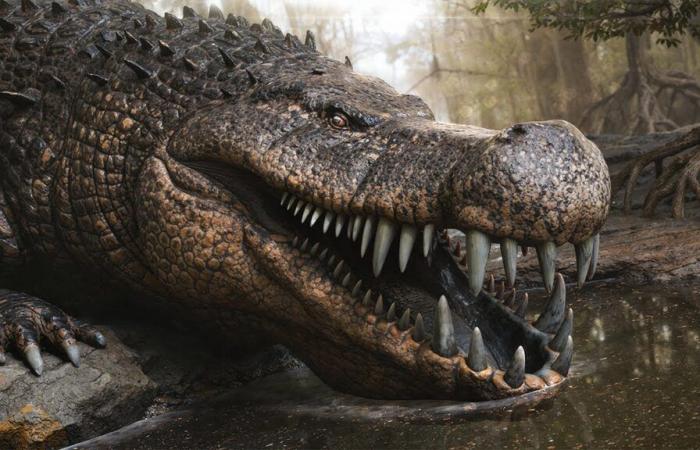80 million years ago, a colossal predator prowled in the marshes and estuaries of North America. With a body up to 8 meters long, formidable teeth and a well -deserved reputation of terror, this reptile – Deinosuchusliterally the “crocodile of terror” – was a dominant figure of his time. If it seems straight out of a prehistoric horror film, its domination over the aquatic ecosystems of the Cretaceous was in no way chance. A recent study highlights the amazing adaptations that made this animal a real nightmare for dinosaurs.
A predator adapted to salt waters
One of the most significant discoveries of this new study concerns the ability to Deinosuchus to live in salt water. Unlike modern alligators, which depend strictly on alternative waters, Deinosuchus had salt glands – specialized organs to eliminate excess salt. This aptitude gave him great freedom of movement in marine circles.
Thanks to this, it could move easily along the Western inner maritime route, a huge shallow sea which divided North America at the time. Where other species were limited to restricted habitats, Deinosuchus was able to colonize the coastal estuaries and marshes on both sides of the continent, thus considerably extending its hunting territory.
An impressive size at the service of hunting
But beyond its mobility, it is above all its titanic size that impresses. With its 8 meters long – or even more – Deinosuchus The current crocodiles was surpassed by far. This extraordinary stature allowed him to face gigantic prey, including dinosaurs, who ventured in his aquatic field.
Fossil traces support this idea: teeth marks of this “terror crocodile” have been found inlaid in dinosaurs. This evidence suggests that he was not content to consume carcasses, but actively hunted his prey. He probably enjoyed shallow waters, where the dinosaurs came to drink, to tender them devastating ambushes.
-Its anatomy was perfectly carved for this type of predation. Deinosuchus had a massive, elongated and wide skull, with a unique bulbous outgrowth among known Crocodilians. His overpowered jaw could grind the most resistant flesh, while his long teeth, comparable to bananas in size, were ideal for perforating and holding his victims.
A separate line
For a long time, Deinosuchus was considered a close relative of crocodiles or modern alligators. But recent research has rebuilt the cards. By studying genetic data from current Crocodilians, scientists discovered that Deinosuchus actually belonged to a distinct evolutionary line, very early separated from that of the alligatoroids.
This new ranking explains some of its atypical characteristics, such as its salt glands, now absent from alligators. He also suggests that Deinosuchus has evolved in a radically different direction, taking advantage of its coastal environment to become a super-predator. The primitive alligators were much smaller and their growth towards larger sizes only occurred after the disappearance of their giant rivals.
In short, Deinosuchus was not simply a giant crocodile, but the fruit of an evolution perfectly suited to a changing world. Thanks to his salt water tolerance, his impressive size and an anatomy cut for hunting, he knew how to dominate the aquatic ecosystems of the Cretaceous and impose himself as a real nightmare for the dinosaurs. This new study does not only lift the veil on a formidable predator: it reminds us how nature, even 80 million years ago, knew how to create fascinating monsters.








